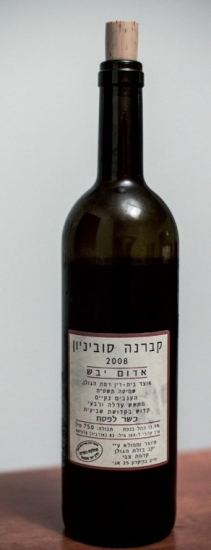
Can a NIS 19 bottle of Cabernet Sauvignon be drinkable? This question is asked and answered in this article.
Sometimes I feel compelled or even destined to tag along when a friend goes for a ride. There’s often a story out there, even if I don’t know it until I see it. Such was the case when my Swedish friend Erik was going shopping at the IKEA furniture store in Netanya. I’ve never been to IKEA in Israel, although I was a fan of the San Diego and Pittsburgh stores when I lived in those cities.
I wasn’t looking for any furniture on this trip, as my modest studio apartment can barely accommodate me and my wine collection, but I was looking for a decanter, since I had seen IKEA’s decanters at a friend’s house and thought they were a good deal for the price.
No such luck; no decanters were on display, although they had an amazing array of affordable stemware at very reasonable prices. After making our way past countless rooms filled with Scandinavian dining tables, beds and mattresses, rugs, lamps and other items, to the most efficient cashiers in Israel, we came across NIS19 bottles of wine in several bins.
I was curious about what wine IKEA might be selling for NIS 19. What plonk could this be? Was it from Sweden? Was it Israeli? Was it some other cheap import I’ve seen in supermarkets?
Even though my Hebrew is limited, I can read well enough to make out a winery’s name and the grape varietal, as well as other wine-related terms.
Imagine my surprise when the generic label on the front of the bottle said the wine was a 2008 Bazelet HaGolan Cabernet Sauvignon. Bazelet HaGolan is a very well respected award-winning winery from the Golan Heights, and the 2008 vintage alluded to the probability that the wine was indeed oak-aged. Given the pedigree of this boutique winery and the probability of oak-aging, there had to be a good story about why this wine was selling so cheaply; their entry level “Bronze” series cost typically about NIS 110 at the winery. As I left IKEA with a bottle, my disappointment at not getting a decanter was lessened by knowing I had walked away with an interesting story for only NIS19.
That night I blind-tasted the wine with some friends, and most said they thought it might easily sell for NIS 60, 70 or even 80. I didn’t think it compared well to other Bazelet HaGolan wines I had tried before, but it was definitely better or just as good as many Israeli wines selling for three to four times the price.
If the wine had been bland or downright awful, the story might have died there, but I found myself thinking this might be the best value wine in Israel, and I fell asleep determined to ask the winery the story behind this wine the next day.
My first thought was that the vintage was a key. 2008 was a shmittah or sabbatical year for kosher wineries in Israel, when Torah-inspired restrictions limit how the wine is marketed. Often shmittah wines are not exported because international inspectors such as the Orthodox Union or the OK withhold kashrut certification, so more Israeli wine remains in Israel during those years and more wines from the previous and following years (in this case 2007 and 2009) are exported to fill the demand.
When I contacted the winery, my initial suspicions were confirmed. As was explained to me, in 2008 the Bazelet HaGolan winery was experimenting with harvesting grapes from an alternative vineyard (at the grower’s request) which was supervised by a different kosher certificating agency than that used for their traditional vineyards. The winemaker, Yoav Levy, was testing whether these grapes would fulfill his expectations of what he wanted from a vineyard that could produce good or even great grapes capable of delivering good or great wine. Having an alternative kosher-supervised vineyard during the shmittah year would give the winery some marketing flexibility with consumers who preferred one certification over the other.
Yet, after about eight months aging in American and French oak barrels and additional time aging in bottles, the wine from these new vines did not result in the complexity, expressiveness and balance that Yoav or the winery’s discriminating customers had come to expect from Bazelet’s NIS 110 “Bronze” wines or their more costly higher series of wines.
I agree that the wine didn’t taste or smell as dynamic as their typical NIS 110 wines, but it was far better than many wines Israeli boutiques are selling for NIS 80 or more. For only NIS 19, it was quite a deal — although one that might be short-lived, with only 900 bottles available.
My only regret in writing this article is that I might sabotage my chances of getting more bottles for myself. At its bargain-basement price, this wine is perfect for those who wouldn’t know the difference from this and Bazelet HaGolan’s more expensive award-worthy wines.
David Rhodes is a consulting sommelier & wine educator living in Raanana. You can contact him with your questions about wine at israeliwineguy@gmail.com
 Chanukah 5773
Chanukah 5773 The Guild launches its season with The Fantasticks
The Guild launches its season with The Fantasticks My Chanukiah
My Chanukiah-1516356428.jpg) Hand in Hand Food Pantry
Hand in Hand Food Pantry Forever Slim
Forever Slim Food Foolish
Food Foolish David Rhodes
David Rhodes